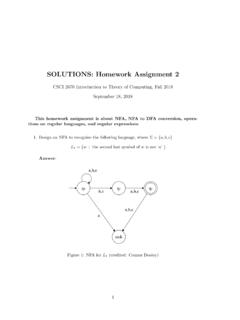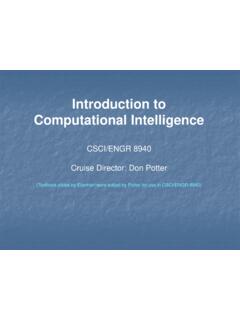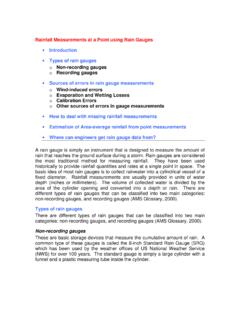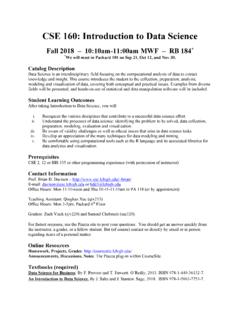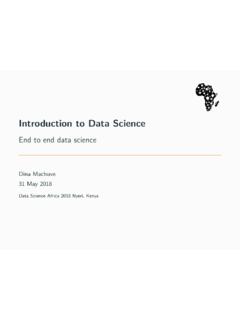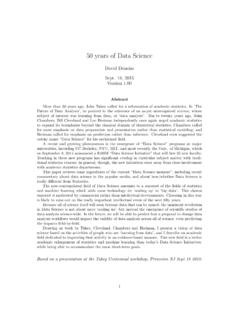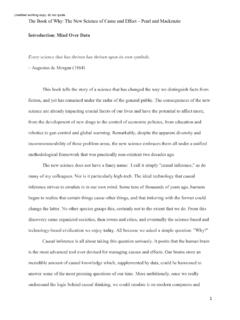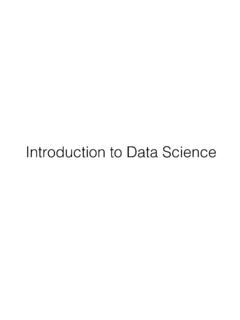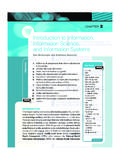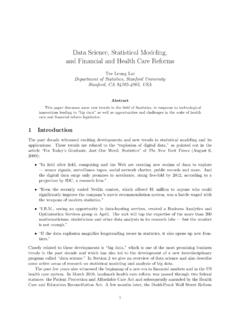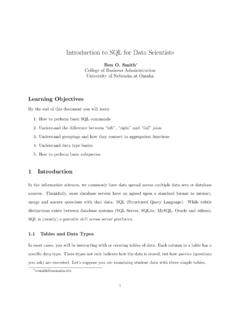Transcription of Introduction to Data Science Using ScalaTion
1 Introduction to data ScienceUsing ScalaTionJohn A. MillerDepartment of Computer ScienceUniversity of GeorgiaOctober 14, 20192 Contents1 Introduction to data data Science .. A data Science Project .. Additional Textbooks ..172 Mathematical Probability .. Measure .. Variable .. Distribution Function .. Mass Function .. Density Function .. Mode .. Conditional Mass and Density .. Conditional Expectation .. Conditional Independence .. Odds .. Example Problems .. Estimating Parameters from Samples .. Exercises .. Further Reading .. Linear Algebra .. System of Equations .. Inversion .. Operations .. Calculus .. Operations .. Factorization .. Representation .. Exercises .. Further Reading .. Notational Conventions .. Model ..433 data Management and Analytics Databases .. Relational Algebra API .. API.
2 API .. Preprocessing .. Identifiers .. String Columns to Numeric Columns .. Missing Values .. Outliers .. Techniques .. Feature Selection .. Multiple Time Series .. Vectors and Matrices .. Excercises ..514 Predictor .. Null Model .. Simpler Regression .. Simple Regression .. Regression .. Inversion Technique .. Factorization Technique .. Factorization Technique .. Factorization Technique .. Value Decomposition Technique .. of Factorization in Regression .. Assessment .. Validation .. Feature Selection .. Exercises .. Further Reading .. Ridge Regression .. Hyper-parameter .. Lasso Regression .. Stategies .. Hyper-parameter .. Reading .. Transformed Regression .. Quadratic Regression .. Response Surface Regression .. Quadratic with Cross Terms .. Cubic .. Exercises .. Weighted Least Squares Regression.
3 Exercises .. Polynomial Regression .. Exercises .. Trigonometric Regression .. Exercises .. ANCOVA .. Handling Categorical Variables .. ANOVA .. ANCOVA Implementation .. Exercises .. General Linear Models .. 1125 Classifier .. ClassifierInt .. Confusion Matrix .. Bayes Classifier .. Null Model .. Naive Bayes .. the Probability .. Conditional Probabilities .. Smoothing .. Selection .. Cross-Validation .. Tree Augmented Na ve Bayes .. Learning .. Probability Tables .. Forest Augmented Na ve Bayes .. Network Augmented Na ve Bayes .. Network Classifier .. Learning .. Probability Tables .. Markov Network .. Markov Blanket .. Factoring the Joint Probability .. Exercises .. Decision Tree ID3 .. Entropy .. Example Problem.
4 Early Termination .. Pruning .. Exercises .. Hidden Markov Model .. Example Problem .. Forward Algorithm .. Backward Algorithm .. Viterbi Algorithm .. Training .. Reestimation of Parameters .. Exercises .. 1526 Classification: Continuous ClassifierReal .. Gaussian Naive Bayes .. Simple Logistic Regression .. Function .. Function .. Likelihood Estimation .. Function .. Function .. inScalation.. Logistic Regression .. Simple Linear Discriminant Analysis .. Linear Discriminant Analysis .. K-Nearest Neighbors Classifier .. Learning .. Decision Tree C45 .. Problem .. Random Forest .. Support Vector Machine .. 1767 Generalized Linear Reading .. Exponential Regression .. Poisson Regression .. 1818 Generalized Additive Regression Trees.
5 Problem .. Thresholds .. 1869 Non-Linear Non-Linear Regression .. Perceptron .. Weights/Parameters .. Functions .. Multi-Output Prediction .. Equation .. Two-Layer Neural Networks .. Version .. Three-Layer Neural Networks .. Version .. Multi-Hidden Layer Neural Networks .. of Nodes in Hidden Layers .. of Overfitting .. 21710 Temporal ForecasterVec .. Auto-Correlation Function .. Auto-Regressive (AR) Models .. AR(1) Model .. AR(p) Model .. Training .. Forecasting .. Exercises .. Moving-Average (MA) Models .. MA(q) Model .. Training .. Exercises .. ARMA .. Selection Based on ACF and PACF .. Exercises .. ARIMA .. ARIMAX .. SARIMA .. Exponential Smoothing .. Dynamic Linear Models .. Example: Traffic Sensor .. Kalman Filter.
6 Training .. Exercises .. Neural Networks (RNN) .. Gate Recurrent Unit (GRU) Networks .. Long Short Term Memory (LSTM) Networks .. Convolutional Networks (TCN) .. Parameter Estimation .. Non-Linear Least Squares (NLS) .. Least Squares Approximation (LSA) .. 24311 Spatial Convolutional Neural Networks .. 24612 KNNP redictor .. Exercises .. Clusterer .. K-Means Clustering .. Initial Assignment .. Reassignment of Points to Closest Clusters .. Training .. Exercises .. K-Means Clustering - Hartigan-Wong .. Adjusted Distance .. Exercises .. K-Means++ Clustering .. Picking Initial Centroids .. Exercises .. Clustering Predictor .. Training .. Exercises .. Hierarchical Clustering .. Exercises .. Markov Clustering .. Exercises .. 26613 Dimensionality Reducer.
7 Principal Component Analytics .. 27114 Functional data Basis Functions .. Functional Smoothing .. Functional Principal Component Analaysis .. Functional Regression .. 27715 Simulation Introduction to Simulation .. Tableau Oriented .. Event Oriented .. Event Scheduling .. Event Graphs .. Process Interaction .. 29616 Optimization Used in data Gradient Descent .. Line Search .. Application to data Science .. Exercises .. Stochastic Gradient Descent .. Stochastic Gradient Descent with Momentum .. Method of Lagrange Multipliers .. Example Problem .. Karush-Kuhn-Tucker Conditions .. Active and Inactive Constraints .. Augmented Lagrangian Method .. Example Problem .. Exercises .. Quadratic Programming .. Coordinate Descent .. Conjugate Gradient .. Method .. Direction Method of Multipliers.
8 Simplex .. 31517 Parallel and Distributed MIMD - Multithreading .. SIMD - Vector Instructions .. Message Passing .. Distributed Shared Memory .. Microservices .. Distributed Functional Programming .. 32310 Chapter 1 Introduction to data data ScienceThe field of data Science can be defined in many ways. To its left is Machine Learning that emphasizesalgorithms for learning, while to its right is Statistics that focuses on procedures for estimating parame-ters of models and determining statistical properties of those parameters. Both fields developmodelstodescribe/predict reality based on one or more datasets. Statistics has a greater interest in making inferencesor testing hypotheses based upon datasets. It also has a greater interest in fitting probability distributions( , are the residuals normally or exponentially distributed).The common thread is modeling.
9 A model should be able to makepredictions(where is the hurricanelikely to make landfall, when will the next recession occur, etc.). In addition, it may be desirable for a modelto enhance theunderstandingof the system under study and to addresswhat-iftype questions (perspectiveanalytics), , how will traffic flow improve/degrade if a light-controlled intersection is replaced with be viewed as replacement for a real system, phenonema to process. A model will map inputsinto outputs with the goal being that for a given input, the model will produce output that approximatesthe output that the real system would produce. In addition to inputs and outputs, some models includestate information. For example, the output of a heat pump will depend if it is in the heating or coolingstate (internally this determines the direction of flow of the refrigurant). Further, some types of models areintended to mimic the behavior of the actual system and facilitate believable animation.
10 Examples of suchmodels are simulation models. They support prescriptive analytics which enables changes to a system totested on the model, before the often costly changes to the actual system are under categories of modeling are dependent of the type output (also called response) of the model. Whenthe response is treated as a continuous variable, apredictive model( , regression) is used. If the goalis to forecast into the future (or there is dependency among the response values), aforecasting model( , ARIMA) is used. When the response is treated as a categorical variable, aclassification model( ,support vector machine) is used. When the response values are largely missing, aclustering modelmay beused. Finally, when values are missing from a data matrix, animputation model(k-nearest neighbors) orrecommendation model( , low-rank approximation Using singular value decomposition) may be reduction( , principal component analysis) can be useful across prerequisite material for data Science includes Vector Calculus, Applied Linear Algebra and Calculus-11based Probability and Statistics.

